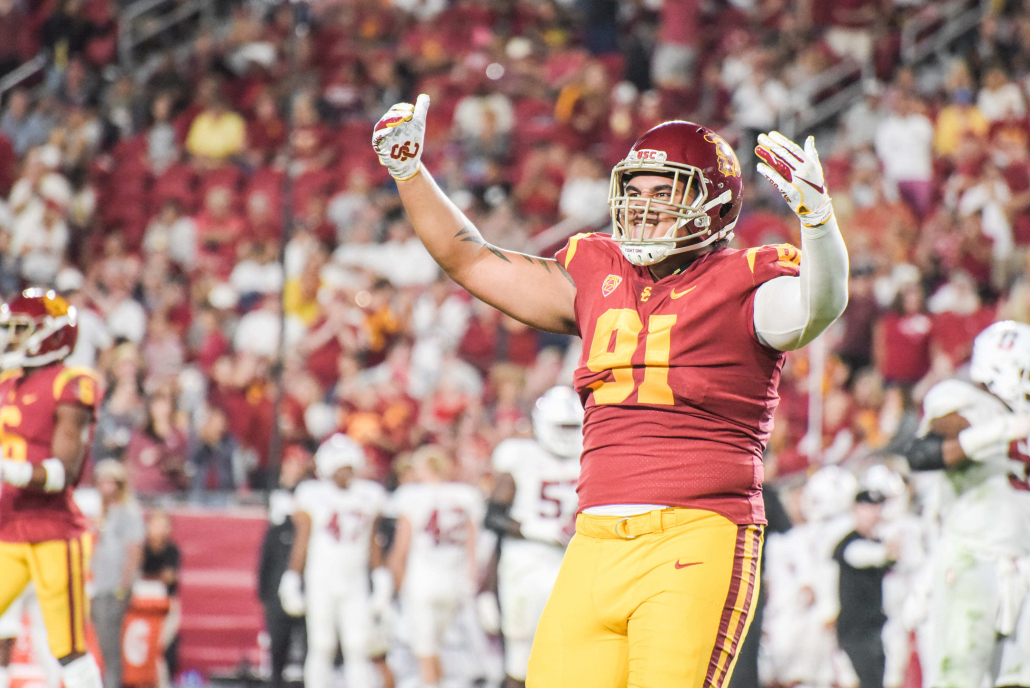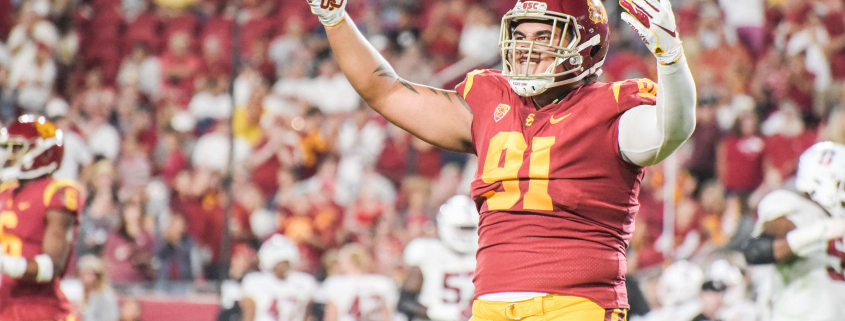Skeletons and vows: Trojans and Cardinals have history

The Trojans have had a long history of battles with Stanford since 1910. USC leads the series, but history shows there is no love lost between the two Pac-12 powerhouses. (Sarah Ko | Daily Trojan file photo)
While recent Trojans might remember the Stanford game as the place where a star was born; then freshman quarterback Kedon Slovis took on the starting job and almost single-handedly revived hopes for the 2019 season in a 45-20 win, the bad blood between the Cardinal and Trojans has existed long prior.
As USC’s oldest current rival (dating back to 1905) and the only other private school in the Pac-12, the two teams have clashed time and time again, leading to iconic moments, unexpected comebacks and a rivalry including fans, players and coaches.
“I think it’s been a rivalry that’s been dominated by USC most of the time, but there have been pockets of time when Stanford’s been very competitive and been a very worthy opponent,” said Jeff Fellenzer, an associate professor of professional practice specializing in sports, business and media at Annenberg.
The rivalry has led to moments such as the 1980 game at Stanford, where the Stanford band had a Trojan-helmeted human skeleton riding a horse’s skeleton in a mockery of Traveler during halftime. In a more recent instance in 2012, the Stanford band leader showed up dressed as the Trojan mascot.
With USC dominating the series with a 63-33-3 lead, here is a look at some classic moments during the rivalry before Saturday’s game as the Trojans’ face their rival Stanford in their first Pac-12 matchup of the season.
The “Vow Boys” & the beginning of a rivalry
The rivalry truly took a turn with the “Vow Boys” in 1932. Stanford had just lost to USC 13-0 when freshman quarterback Frank Alustiza and freshman fullback Bobby Grayson made a vow that they would “never lose to the Trojans.” They kept true to their promise and went on to win three years in a row against USC — who had previously been on a 27-game win streak. The “Vow Boys” went to the Rose Bowl three consecutive seasons finally culminating in a Rose Bowl win their final year.
The “Wild Bunch” and an unexpected comeback in 1969
1969 was the year of the notorious USC defensive line monikered the “Wild Bunch.” The Trojans finished 10-0-1, coming off a 1967 national title and a 1968 Rose Bowl loss to Oregon State. Led by Black quarterback Jimmy Jones and an all-Black defensive line — rare at the time — and under head coach John McKay, the Trojans would go on to defeat Michigan in the Rose Bowl. Their impressive record didn’t come easy and involved an unexpected comeback against Stanford.
The Stanford offense was led by junior quarterback Jim Plunkett (who would go on to become the first Mexican American Heisman winner the following season) and had a 12-0 lead going into the second quarter.
Going into halftime, USC was barely ahead at 14-12 when Stanford scored a field goal with three minutes left in the game, going up 24-23. In what was an unexpected comeback, the Trojans stole the victory with a Ron Ayala field goal as time ran out. It was set up by a conversion on 4th and 5 at USC’s own 20 with no timeouts after a run by tailback Clarence Davis. The Trojans ended up with a 26-24 win.
Stanford strikes back at the 2007 game
In another close call and revenge for a 42-0 loss the previous year, the Cardinal defeated the Trojans 24-23. Entering the game, ranked No. 2 in the AP poll, USC was a 41-point favorite and had a 35-game home winning streak. It was Jim Harbaugh’s first season as Stanford head coach; he and USC head coach Pete Carroll would go on to have an intense rivalry.
The upset was secured with a 10-yard touchdown pass from redshirt sophomore quarterback Tavita Pritchard to wide receiver Mark Bradford with 49 seconds remaining in the game to put the Cardinal ahead. To add insult to injury, Bradford attended high school at Fremont High School in Los Angeles.
“It was someone who came back to kind of haunt USC from L.A.,” Fellenzer said. “That was Jim Harbaugh’s first season as coach. So, at that point he built the program up. But the very first year, they have this epic comeback.”
“What’s your deal?” and Stanford’s demolition of 2009
In what would become an infamous game and the highest margin of loss against Stanford, the Cardinal defeated the Trojans 55-21 in 2009. It was USC’s worst loss in the Coliseum in 43 years and took place during Homecoming with a crowd of 90,071 in attendance.
With a 48-21 lead in the fourth quarter, Harbaugh attempted a two-point conversion attempt drawing ire from the crowd. This led to a heated exchange between Harbaugh and Carroll during the traditional handshake between the coaches at the end of the game with Carroll asking Harbaugh, “What’s your deal?” and Harbaugh replying with “What’s your deal?” The slogan would go on to become Stanford’s phrase for it’s season ticket packages.
Stanford tailback Toby Gerhart rushed for 178 yards and three touchdowns in the win. An All-American and 2009 Heisman Trophy runner up who was drafted in the second round by the Minnesota Vikings, Gerhart was heavily recruited out of high school and turned down the Trojans’ offer of playing fullback or linebacker.
Rounding up into the present
Other notable games between the two teams include the 1979 game when Stanford tied USC 21-21. With last-minutes comebacks and a couple of close one-point games, including Stanford defeating USC 13-12 in 1926, 24-23 in 2007 and USC winning 31-30 in 1995, there is no knowing which team will pull off the win.
The Trojans will look to maintain their winning streak from 2019 and replicate Slovis’ success against Stanford going into Saturday’s game. The Trojans’ are 17-point favorites, but if history has shown anything, the game might be too close for comfort.

